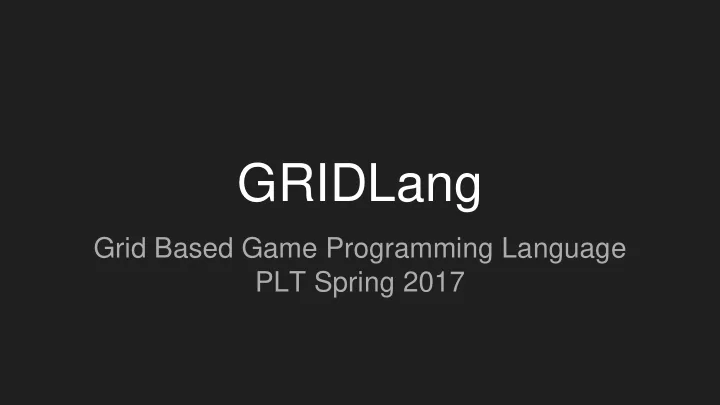

GRIDLang Grid Based Game Programming Language PLT Spring 2017
Team Player Akshay_Nagpal, Dhruv_Shekhawat, Parth_Panchmatia, Sagar_Damani ;
Main Goals Design games in an intuitive and expressive manner • Quickly prototype grid-based games and get a programmatic view • Simplify the process of : • defining rules for a game • grid creation and manipulation • in-built language components that enable programmer to express • more with less lines of code
Core Features Strongly typed • Move Driven • Structs, Pointers, Arrays(1D & 2D) • Standard Library •
Initialize Grid _______ Grid_Init<7,7>; 0123456 | | | | | | | |0 | | | | | | | |1 | | | | | | | |2 | | | | | | | |3 | | | | | | | |4 | | | | | | | |5 | | | | | | | |6 ------------
Creating Player and item structs Player { Piece horse h1,h2,h3; int score; } Piece horse { int value; }
Adding to Grid Player p1; ______________________ int setup(){ p1.h1.displayString = "h1"; 0__1__2__3__4__5__6_ p1.h2.displayString = "h2"; | | | | | | | |0 p1.h3.displayString = "h3"; | | | | | | | |1 Grid<3,6> <-- p1.h1; | | | | | | | |2 Grid<3,2> <-- p1.h2; | | |h2| | | |h1|3 Grid<5,2> <-- p1.h3; return 0; | | | | | | | |4 } | | |h3| | | | |5 printGrid(); | | | | | | | |6 ---------------------
Grid Initialization NULL NULL NULL NULL NULL NULL NULL NULL NULL
GenericPiece from MiniChess Piece King { Piece GenericPiece // programmer’s code { } Piece King* King_node; Piece Pawn* Pawn_node; Piece Pawn Piece Bishop* Bishop_node; { int x, y ; // programmer’s code Piece GenericPiece* next ; } string nametag, typetag ; Player* owner ; Piece Bishop } { // programmer’s code }
NULL NULL NULL NULL Piece* horse h_node; NULL Piece* bishop b_node = b1; typetag = “bishop” nametag = “b1” owner = “black” NULL NULL NULL
NULL NULL NULL Piece* horse h_node = h1; Piece* bishop b_node; typetag = “horse” NULL Piece* horse h_node; NULL nametag = “h1” Piece* bishop b_node = b1; typetag = “bishop” owner = “black” nametag = “b1” next owner = “black” NULL NULL NULL
Control Flow
Mini Chess
Bishop Rule - Check if Move is Diagonal if(abs(dst_x - src_x) == abs(dst_y - src_y))
Bishop Rule – Check if Diagonal is Blocked if (traverse(src_x, src_y, dst_x, dst_y) == 1) { return 0; }
Colocation int colocation(int x, int y, Piece GenericPiece* i1, Piece GenericPiece* i2) { deleteFromGrid(x,y,i2.nametag); return 0; }
checkGameEnd (Snakes and Ladders) int checkGameEnd() { Piece Token *t; Piece GenericPiece *token; t = getCurrentPlayer(); token = getPieceFromGrid(t.displayString); if (token.x == 0 && token.y == 5){ printGrid(); print("Winner is: "); print(t.displayString); return 1; } return 0; }
Lessons Learned • Have a concrete plan of what your language does. • Team matters a lot. Choose team members based on their ability to learn. • Two heads are better than one.
Recommend
More recommend